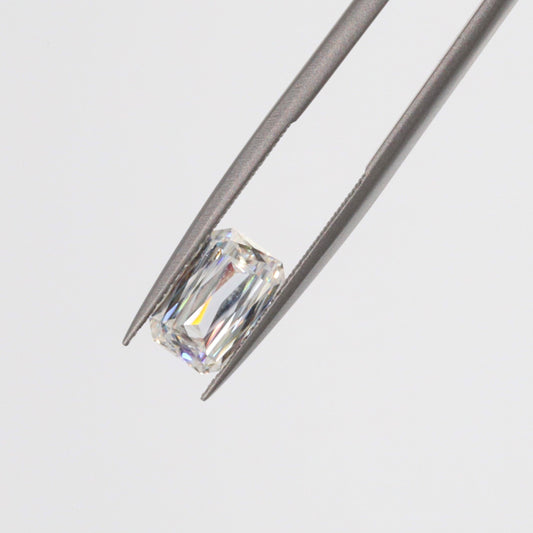Diamond is one of the most precious and expensive gemstones in the world. Therefore, it’s not surprising that there's no shortage of diamond alternatives in the market, from lab-grown simulants to straight-up forgery pieces.
To the untrained eye, it can be impossible to tell a real diamond from a simulant. This makes buying gems from any retailers outside the circle of most trusted sources highly risky.
Fortunately, there's an easy way to check – by using a diamond tester. This helpful little device uses the diamond's chemical properties to check for authenticity.
This article will discuss how to use a diamond tester and whether it will work for other similar gemstones like moissanite.
What is a Diamond Tester?
A diamond checker or tester is a small portable device that determines whether a piece of diamond is genuine or not. It does this by passing heat or electricity (depending on the model) directly to the gemstone and measuring how fast it can conduct them.
Diamond testers work on the scientific principle that different gemstones have distinct chemical structures. Hence, the way heat or electricity travels through a diamond will be drastically different from a gemstone like cubic zirconia.
The one major drawback of most diamond testers is that they cannot tell a real versus a lab-grown diamond apart. That's because synthetic diamonds are structurally and chemically identical to the real thing. This includes thermal and electrical conductivity; thus, it will easily fool a diamond tester pen.
However, the good news is that synthetic diamonds leave tell-tale signs that are easy to spot through other means. These include tests like fluorescence and color zoning.
How to Use a Diamond Tester
It might look intimidating at first, but figuring out how to use Diamond Selector 2 and other types of diamond testing pens is relatively easy. Likewise, most diamond tester instructions are straightforward as well.
As an example, let's see how to operate a GemVue Diamond Tester.
For starters, make sure that the diamond you want to test is clean and placed on a stable surface. Also, check if the room temperature is within the operating threshold of the testing pen (for the GemVue, it should be between 64℉ – 86℉)
Turn on the Diamond Tester and set it to the "Diamond" setting. Then, wait for the device to heat up, which can take around 30 seconds. You'll know it's ready when the green indicator lights up, followed by a short beep.
To test, place the probe's tip directly on top of the diamond at a 90-degree angle. Don't use excessive force as the probe tip might break. Also, make sure that the probe isn't touching anything other than the diamond for accurate results.
How to Read a Diamond Tester

If the diamond tester has a scale, it should light up to the red zone to confirm the diamond is real. If it only reaches the green or yellow zone, the stone is not a real diamond and might be another gemstone or a diamond simulant.
If there's a continuous buzzing sound, it means the testing pen probe has detected metal. Remove the tip and then re-apply it to the diamond, making sure not to touch anything else. If the problem persists, try holding up the diamond in your hand instead.
The Benefits of Using a Diamond Tester Pen
Diamond testers, such as the Diamond Selector 2, are an easy and cost-effective way for anyone to test a diamond's authenticity. You don't need the trained eye of a jeweler or gemologist to ascertain if the gemstone you're buying is real or not. Thus, tester pens allow you to trade or buy diamonds with greater confidence.
The GemVue Diamond Tester pen, in particular, is a state-of-the-art portable checker with advanced features. One of the problems of most diamond checkers is the possibility of a false positive; the pen erroneously detects the metal holding the gem. The built-in metal alert of the GemVue reduces this occurrence significantly.
In addition, the GemVue has an ultraviolet light feature used to test whether a gemstone fluoresces or phosphoresces, which can indicate that a diamond is lab-grown versus mined naturally.
How Does a Diamond Tester Work for Moissanite Jewelry?
Moissanite jewelry is often regarded as a diamond alternative because the two share similar properties. Aside from both having natural clarity and scintillation, they also have identical thermal conductivity. Hence, a diamond tester that uses heat for testing will not distinguish between moissanite and diamond.
Because moissanite and diamonds are nearly indistinguishable to the naked eye, you need a diamond tester that uses electricity instead of heat to tell these two gemstones apart, as moissanite and diamond have distinct electrical conductivity.
The Best Alternative to Testing Your Gemstones
Rather than checking the authenticity of moissanite gemstones yourself, the best course is to buy from a reputable source. At Gema&Co, we ensure that all our moissanite gemstones are authentic and sourced conflict-free and responsibly.
It's the perfect gemstone to celebrate life's special moments. Contact us to start designing your moissanite ring or jewelry today.




